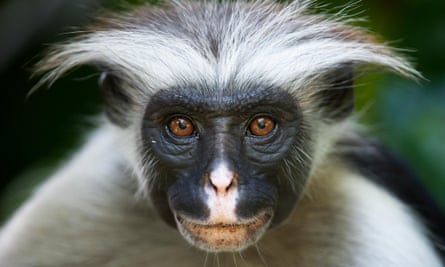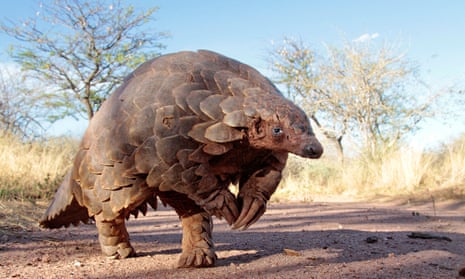If there is a single dish that has come to symbolise humans’ willingness to eat other animals out of existence, it is the ortolan bunting. Traditionally, you devour this diminutive songbird, prized since Roman times, whole, in one fell bite, your head hidden under a napkin to hide your shame from God (although, drowned in armagnac and deep-fried, this “delicacy” is also just plain messy).
In France, where hunting ortolans has been banned since 1999, 30,000 birds are still trapped every year, according to the RSPB; they are said to fetch up to €150 (£130) apiece. Despite conservation efforts, ortolan numbers dropped by 84% between 1980 and 2012.
Yet the International Union for Conservation of Nature (IUCN) lists the ortolan as “a species of least concern”. There are many animals that are in far greater peril, according to Prof David Macdonald of the University of Oxford, who reported in 2016 that our culinary habits threaten 301 land mammal species alone with extinction.
Here are 10 of the creatures that are most at risk, based on Macdonald’s study, guidance from the Marine Conservation Society (MCS), the IUCN’s red list of endangered species and the Zoological Society of London’s (ZSL) Edge of Existence conservation programme.
Chinese giant salamander
Once found across central, south-western and southern China, the world’s largest amphibian has seen its natural population fall by 80% since 1960, according to ZSL’s Olivia Couchman. Despite a Cites appendix I listing (the highest level of protection given by the Convention on International Trade in Endangered Species of Wild Fauna and Flora), specimens reportedly fetch more than $1,500 (£1,150) each on the black market, where they are prized as much as a delicacy as for their medicinal properties. In 2015, the Washington Post reported that undercover reporters from a Chinese newspaper had caught 14 police officers feasting on salamander during a banquet at a seafood restaurant in Shenzen.
Beluga sturgeon

These ancient, supersized fish (they can weigh up to a tonne and a half) could once be found all the way from central Russia to Italy and northern Iran, but overfishing – for their flesh and caviar – and the devastating effect of modern river infrastructure on their migratory spawning patterns have caused their range to contract to just two rivers, the Ural and the Danube, and the basins they feed into, the Caspian and the Black Sea, respectively. As the MCS’s Jean-Luc Solandt says, this is “definitely one that could become extinct within a generation”. With Beluga caviar fetching thousands of pounds a kilo, it’s easy to see why overexploitation remains a problem. And it’s not the only sturgeon in trouble: of the 27 species, the IUCN puts 15 others in the same critically endangered bracket.
Pangolin
Since 2000, more than a million pangolins, the world’s most trafficked wild mammal, are thought to have been killed for flesh and blood, as well as their scales (which is used in traditional Chinese medicine). When all eight species of pangolin were given an appendix I listing in 2016, everyone at the Cites convention is said to have applauded. However, as Oxford University’s Dan Challender points out, alarming seizures continue to take place: 8.3 tonnes of scales (amounting to 13,800 pangolins) in Hong Kong in January (the shipment from Nigeria was bound for Vietnam); 30 tonnes of live and frozen animals and body parts in Malaysia in February. With the Asian species, particularly the Sunda and Chinese, no longer commercially viable because there are so few left, local demand is being met by intercontinental trade. Paul De Ornellas, the chief wildlife advisor at WWF UK, describes this as “one continent hoovering up wildlife from another”.
Angelshark

The MCS says this species is “just one step away from extinction” in the wild. Its range – which until the middle of the 20th century stretched from Norway and Ireland to Morocco and the Black Sea – has contracted by 80%; it has been declared extinct in the North Sea. This bottom-dwelling, sedentary fish is most threatened by trawling for other species, where it forms part of the accidental bycatch.
Yangtze giant softshell turtle (AKA Red river turtle)
Once widespread in Vietnam and China, this species is now down to just four known individuals, thanks to the local appetite for its meat and eggs. With two males in different Vietnamese lakes and the other pair in an as-yet-unsuccessful Chinese captive breeding programme (the male has a damaged penis, according to the New Yorker), Couchman says it would be very surprising if the species survives. This freshwater turtle’s plight highlights that of the wider turtle population: after primates, they are the second-most threatened of the world’s major vertebrate groups.
Eastern lowland gorilla (AKA Grauer’s gorilla)
Found in the mountains of eastern Democratic Republic of Congo, this gorilla is particularly vulnerable to poaching for bushmeat, associated with illegal mining camps. While the other eastern gorilla subspecies – the mountain gorilla – is the only great ape to see its numbers rising, the eastern lowland’s are in steady decline. Although violence in the region has made accurate accounting impossible, its population is estimated to have dropped by 77% in a single generation to 3,800 individuals, according to the Edge of Existence list.
European eel

These mysterious fish migrate from the Atlantic (they are thought to be spawned in the Sargasso Sea) to fresh and coastal waters to grow, then head back out to the ocean to breed. While little is understood about any of the process, juvenile (“glass”) and mature (silver or yellow) eels alike have been consistently overfished, to the point where yields have halved since the 1960s. With excessive exploitation just one of the many threats the eels face, the MCS urges us to “avoid eating European eel at any stage in its lifecycle”.
Red colobus

Christoph Schwitzer of the Bristol Zoological Society says this group of monkey species – there are 18 – is a prime example of large-bodied primates being hunted to extinction “because they make a good family meal”. They are found across sub-Saharan Africa, where habitat degradation and improved road access have seen the commercialisation of bushmeat-hunting, with devastating effects. One species, Miss Waldron’s red colobus, is already feared extinct, having not been seen in the wild since 1978, while the most recently discovered, the Niger delta red colobus, is on track to disappear within the next five years.
Indri (AKA babakoto)
Madagascar’s lemurs – of which the singing, black-and-white indri is the largest – are the world’s most endangered primate group: 105 of the island’s 111 known species and sub-species are threatened with extinction. While habitat degradation due to slash-and-burn agriculture has long been an issue (with human eating habits posing an indirect threat), the past 15 years have seen an alarming rise in subsistence hunting and commercial poaching for local restaurants, according to Schwitzer. This new threat is linked to the island’s political and economic crisis. As Couchman puts it, people are starving.
Saola
They may look like antelopes, but these large forest-dwelling mammals, found in the Annamite Mountains along the border between Laos and Vietnam, are more closely related to wild cattle and buffaloes. Western science only got wind of their existence in the early 1990s, when horns were found in the homes of Vietnamese hunters. Little is still known about them today, including how many are left. The Edge of Existence list says it could be as few as 30 left. For De Ornellas, the saola is linked to “empty forest syndrome”, a real concern for this region of south-east Asia where almost all the large animals have been hunted out for food.

Comments (…)
Sign in or create your Guardian account to join the discussion